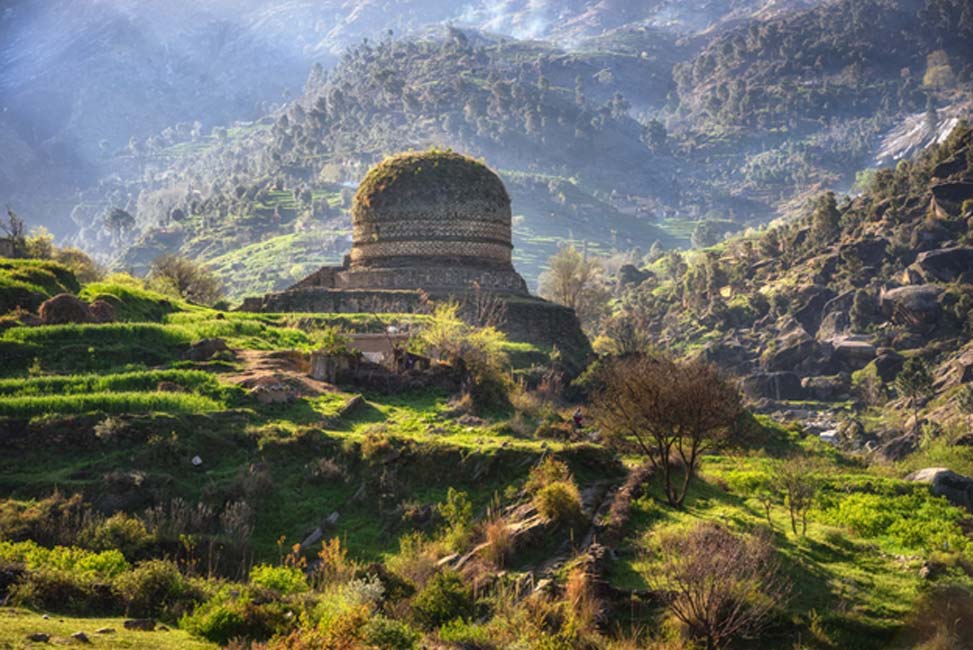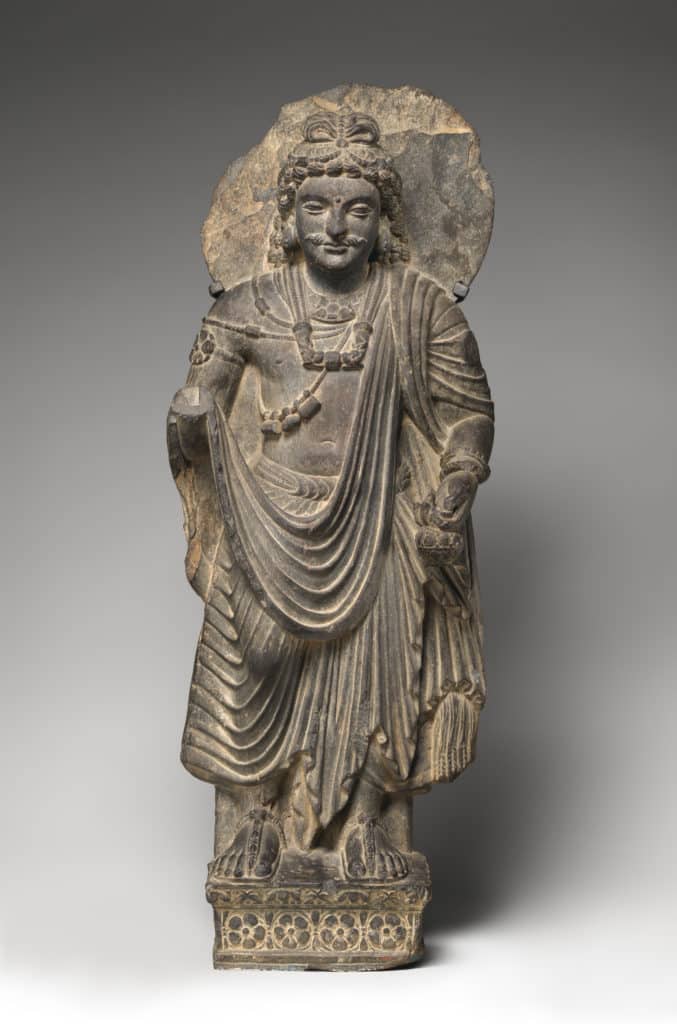
The ancient region of Gandhara was located in what is today northwest Pakistan. It was an astonishingly wealthy area due to its position along the Silk Road that linked it to South Asia and the Mediterranean1.
The art of this region fused together foreign styles, like Greco-Roman and Indian styles, to create a visual form of the Buddhist religious ideals that existed in Gandhara. The earliest sculptures with Buddhist context in Gandhara dates back to the first-century 2.
One would say that a Bodhisattva is an enlightened being who forsakes Nirvana in order to help others reach their own first3. They are in the beginnings of becoming a Buddha.

There are many Bodhisattvas, one being the Maitreya, who is the Buddha of the future that will be born to teach enlightenment in the future. It is said that Maitreya will be born a miraculous birth, live in a palace, reach enlightenment, reveal the dharma, and then die4. One can identify Maitreya by the sacred flask he carries in his left hand and his luxurious attire and ornaments that signify his wait in heaven.
At the Metropolitan Museum of Art, you will find a Standing Bodhisattva Maitreya (Buddha of the Future), with film star looks that are allied with a naturalistic treatment of the body and draperies, who originates from the ancient region of Gandhara.
Standing 163.2cm tall, 53.3cm wide, and 20.3cm5 deep the statue is carved from schist that allowed its sculptor to carve deep details into the hairstyle, drapery, and jewelry that adorns this Bodhisattva.
Schist is a metamorphic rock formed from mudstone or shale6. It is a remarkably strong, durable, capable stone. The stone sparkles with a dazzling luster that comes from mica minerals that often contain quartz. Using an abrasive method allows for the tougher rock to be cut and carved to the artist’s will.
There are many intricate details of the statue. Bodhisattva Maitreya has an extravagant hairstyle held in place by a beaded net, with a crescent moon decorating on top. The Gandharan style is shown with an urna placed upon his forehead, his sharp eyebrows, lotus petal eyes, soft nose, and fleshy cheeks.
On his neck sits multiple chains holding a medallion, which is common on bodhisattva images. The terminals of the chains are in the front and fastened in the same fashion of Indian pearl necklaces7. The flask in his left hand is broken off but the lid remains in the lowered hand. Although his right hand is broken off you can see that it is made of a separate piece of stone8 and is most likely in Abhaya Mudra. Mudras are sacred hand gestures that materialize the nature and functions of the Buddhas9.
Abhaya Mudra is the mudra symbol of protection, benevolence, peace, and the dispelling of fear. It is most often seen with the right hand raised to shoulder height with the palm facing outward as the left-hand hangs down beside the body 10. It appears as a natural gesture as a sign of good intentions. In Gandharan art, this mudra was also used as an indication of preaching. The halo around his head is a type of religious iconography. It symbolizes how holy, or sacred the subject of the masterpiece is.
Footnotes
Kossak, Steven, and Edith W. Watts. 2001. The Art of South and Southeast Asia: a Resource for Educators. New York: The Metropolitan Museum of Art, 3.
2 Kossak, Steven, and Edith W. Watts. 2001. The Art of South and Southeast Asia: a Resource for
Educators. New York: The Metropolitan Museum of Art, 26.
3 Kossak, Steven, and Edith W. Watts. 2001. The Art of South and Southeast Asia: a Resource for
Educators. New York: The Metropolitan Museum of Art, 53.
4. Kossak, Steven, and Edith W. Watts. 2001.The Art of South and Southeast Asia: a Resource for Educators. New York: The Metropolitan Museum of Art, 53.
5Kossak, Steven, and Edith W. Watts. 2001. The Art of South and Southeast Asia: a
Resource for Educators. New York: The Metropolitan Museum of Art, 55.
6Kirk, Karin. 2019. “Schist Happens: Get to Know This Brilliant Stone.” Use Natural Stone. February 7, 2019. https://usenaturalstone.org/schist-happens-get-know-brilliant-stone/.
7Metropolitan Museum Journal . 2007. Vol. 42. New York: The Metropolitan Museum of Art,
68.
8Kossak, Steven, and Edith W. Watts. 2001. The Art of South and Southeast Asia: a
Resource for Educators. New York: The Metropolitan Museum of Art, 56.
9Louis-Frédéric , and Nissim Marshall. 1995. Buddhism. Paris: Flammarion, 40.
10Louis-Frédéric , and Nissim Marshall. 1995. Buddhism. Paris: Flammarion, 41.
Works Cited
- Kirk, Karin. 2019. “Schist Happens: Get to Know This Brilliant Stone.” Use
- Natural Stone. February 7, 2019. https://usenaturalstone.org/schist -happens-get-know-brilliant-stone/.
- Kossak, Steven, and Edith W. Watts. 2001. The Art of South and Southeast
- Asia: a Resource for Educators. New York: The Metropolitan Museum ofArt
- Louis-Frédéric , and Nissim Marshall. 1995. Buddhism. Paris: Flammarion
- Metropolitan Museum Journal . 2007. Vol. 42. New York: The MetropolitanMuseum of Art
